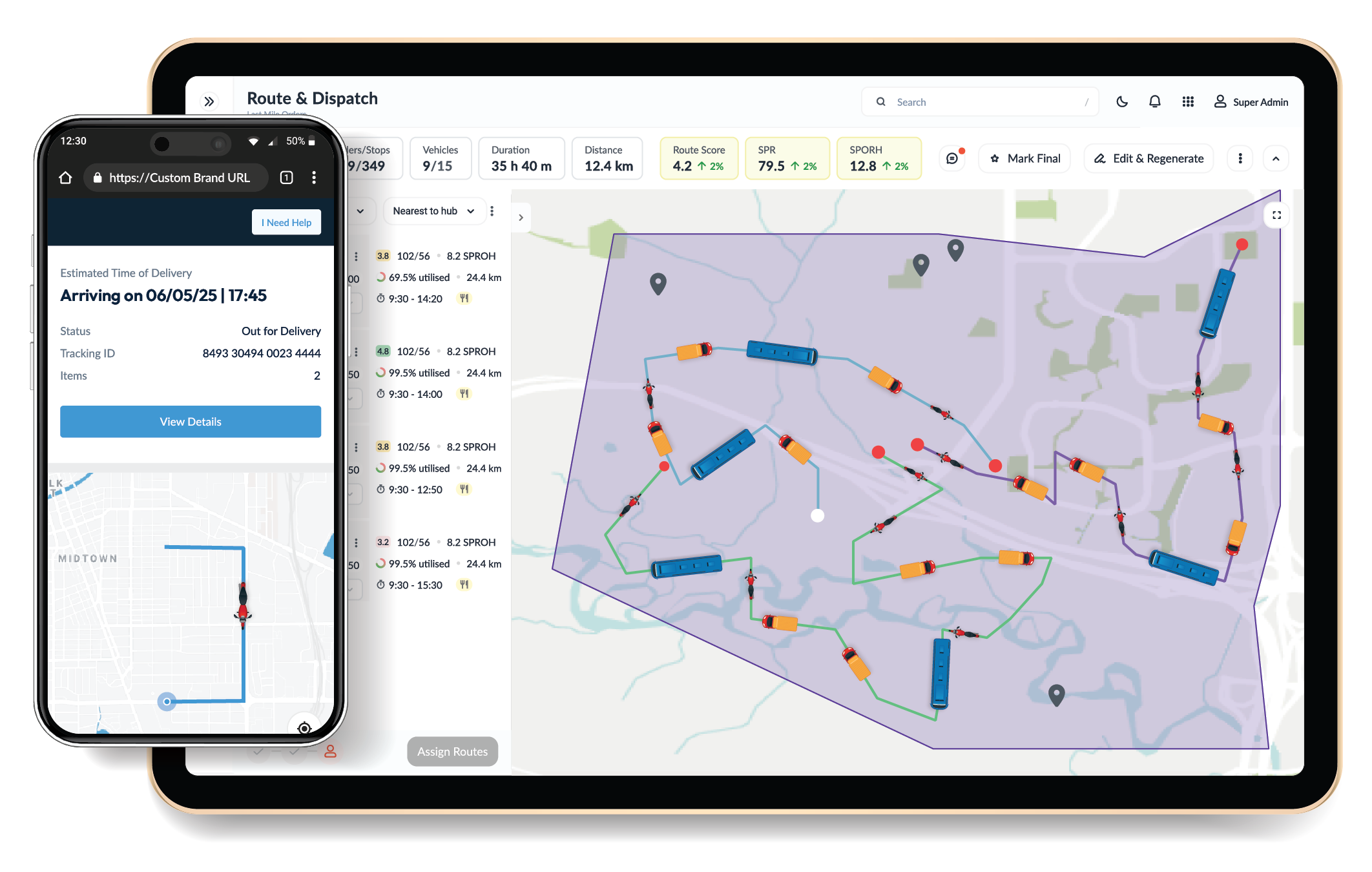- AI Route
AI Route Optimization: Reducing Empty Miles and Controlling Costs
Table of Contents
- The Business Cost of Empty Miles
- Why Traditional Routing Falls Short
- The AI Route Optimization Advantage
- Multi-Stakeholder Benefits: Dispatcher, Driver, and Customer
- Beyond Delivery: Addressing Installation and Service Complexity
- Reducing Empty Miles: A Practical Approach
- The Cost Control Payoff
- Building the Future of Delivery with AI

AI route optimization helps enterprises eliminate empty miles and recover margin on every delivery. For businesses handling bulky goods and tight SLAs, the pressure to optimize every route is higher than ever.
Empty miles trips without cargo add up quickly, driving up costs and stretching resources thin. According to the American Transportation Research Institute, the average marginal cost to operate a truck is $2.27 per mile, a record high.
With AI-powered route optimization, logistics leaders can address these challenges head-on by improving vehicle utilisation and minimising wasted journeys. Picture a family waiting for their new refrigerator, only for the delivery to be delayed by traffic, a missed installation crew, or a rescheduled slot. Each disruption not only inconveniences customers but also forces logistics teams into costly, empty return trips.
Reducing these miles isn’t just about saving fuel; it’s about unlocking better service, tighter cost control, and a more resilient supply chain in an era where every mile matters.

The Business Cost of Empty Miles
Every empty mile represents lost potential. It may look small per trip, but the cumulative impact is material, especially as customer expectations grow for same-day delivery, precise installation, and seamless returns.
When large items are involved, additional complexities come into play: two-person teams, skill mapping for installation, time-bound delivery slots, and urban parking constraints.
Missed or delayed deliveries don’t just cost fuel; they often mean rescheduling crews, risking SLA breaches, and, at worst, losing customer trust. For enterprise dispatchers, the focus has shifted from simply getting the delivery there to ensuring vehicles are optimally utilized, teams arrive prepared, and every trip delivers value both for the business and for the end customer.
Why Traditional Routing Falls Short
Many organizations still rely on legacy systems for routing, often leading to inefficiencies that modern delivery demands can no longer afford. Traditional routes rarely reflect the on-the-ground realities like new service areas, construction zones, seasonal traffic surges, or sudden driver shortages.
When a customer orders an air conditioner and requests a specific installation window, it’s not just about sending the nearest truck. The right crew, equipped for both delivery and installation, must be matched with available vehicles, the customer’s time preference, and the likely parking scenario at their location.
Traditional route planning can’t juggle these variables in real-time, and as a result, empty miles accumulate, fuel is wasted, SLAs are missed, and the customer’s experience is compromised.
The AI Route Optimization Advantage
With the rise of AI-based route optimization, logistics teams now have access to real-time intelligence, dynamic decision-making, and predictive analytics, all of which are critical for reducing empty miles and controlling costs. AI-based routing solutions use advanced machine learning algorithms to process thousands of variables every minute, from live traffic feeds to driver skills, parking availability, delivery windows, and even installation requirements.
FarEye’s Smart suite brings this to life by transforming routing from a fixed, one-size-fits-all process into an adaptable, data-driven engine. Imagine a scenario where a washing machine delivery is unexpectedly rescheduled.
AI can automatically reroute available trucks and skilled installation teams to fill that time slot, match parking recommendations, and update the customer all before the original crew even leaves their last stop.
Multi-Stakeholder Benefits: Dispatcher, Driver, and Customer
Every stakeholder in the delivery chain faces distinct challenges. AI-powered routing ensures all their needs are balanced, delivering a unified operational benefit.
- For Dispatchers
The job is no longer about reactive problem-solving. With AI-based route optimization software, dispatchers can forecast demand spikes, plan for variable traffic conditions, and even predict driver availability using historical data.
FarEye’s rate-based routing engine considers factors like tolls, fuel prices, driver schedules, and customer preferences to generate the most efficient routes in real time. This not only lowers operational expenses but also boosts on-time delivery performance.
- For Drivers
AI addresses “last-mile chaos.” Enhanced address intelligence ensures stop durations are mapped accurately, improving ETA accuracy. FarEye’s Smart Parking feature analyzes historical data and predicts available parking spots, minimizing the time spent searching and reducing driver fatigue.
SmartTrip goes further by continuously monitoring driver behavior, forecasting potential disruptions, and dynamically adjusting routes in response, keeping every trip as productive as possible.
- For Customers
Convenience is now an expectation. AI enables flexible delivery slot selection, reducing missed deliveries and failed installations. With FarEye, customers receive accurate ETAs, proactive notifications, and even GenAI-powered chat support for real-time answers.
Whether a delivery needs installation or a specific crew, AI ensures the right resources are matched and every commitment is met, resulting in fewer complaints and higher satisfaction.
Beyond Delivery: Addressing Installation and Service Complexity
Not all deliveries end at the doorstep. With high-value, big & bulky products, installation, assembly, or skill-based tasks are often part of the experience. AI-powered route optimization isn’t just about getting packages to the right address; it’s about skill mapping and service precision.
Take the case of a customer ordering a smart washing machine. The software knows not just which truck is available but which team is certified for smart appliance installation, which routes have the best chance of parking, and how long each stop is likely to take, including elevator wait times or carry-in durations. If a job overruns, the system reallocates the next best crew, eliminating idle truck time and ensuring no one is left waiting.
By adapting to real-world constraints and customer requirements, AI-based routing makes the entire process from scheduling to service smarter, more reliable, and more cost-effective.
Reducing Empty Miles: A Practical Approach
Cutting empty miles demands more than better maps. It requires the orchestration of vehicles, people, and information continuously and at scale. AI route optimization delivers on this promise by:
- Dynamically clustering deliveries and pickups to maximize vehicle fill rates and minimize idle legs.
- Predicting demand and pre-scheduling pickups, returns, or reverse logistics to fill potential gaps on return journeys.
- Integrating with telematics and inventory systems, ensuring real-time visibility and proactive reallocation if a delivery is delayed or canceled.
- Providing predictive service times by factoring in parking, building access, and even weather allows dispatchers to plan for real-world challenges.
- Offering real-time communication to customers and field teams, aligning expectations, and reducing unnecessary trips caused by missed connections.
By approaching routing as a fluid, ecosystem-wide process, businesses unlock cost control while also boosting service levels.
The Cost Control Payoff
The benefits of reducing empty miles are both immediate and long-term. Direct fuel savings, lower maintenance costs, and improved asset utilization all add up. But the real impact goes deeper. More efficient routes mean fewer vehicles needed for the same workload, reduced overtime, and greater compliance with delivery promises.
Sustainability goals are met with fewer emissions per delivery. Driver turnover is reduced as productivity and satisfaction rise. For customers, faster, more predictable deliveries and installations build loyalty and trust, turning routing efficiency into a true competitive advantage.
Building the Future of Delivery with AI
AI route optimization has moved beyond trend status; it is the new standard for enterprises aiming to control costs and elevate the delivery experience. Every mile saved is money back in the business, fewer empty runs for drivers, and more time for customers to enjoy their new appliances, furniture, or electronics without the stress of missed appointments.
With FarEye, businesses can fine-tune every aspect of routing, installation, and service, adapting on the fly to meet demand, reduce waste, and exceed customer expectations. As the delivery landscape evolves, embracing AI-based routing and machine learning is how leading enterprises are setting the pace, maximizing efficiency, and transforming cost control from a goal into a daily reality.
See how AI-powered route optimization can cut empty miles and lower costs for your fleet. Request a demo.
Source:

Komal Puri is a seasoned professional in the logistics and supply chain industry. As the AVP of Marketing and a subject matter expert at FarEye, she has been instrumental in shaping the industry narrative for the past decade. Her expertise and insights have earned her numerous awards and recognition. Komal’s writings reflect her deep understanding of the industry, offering valuable insights and thought leadership.
Let's Talk to Our Experts and Optimize Your Deliveries Today!
An expert from our team will reach out within 24 hours
Related resources


